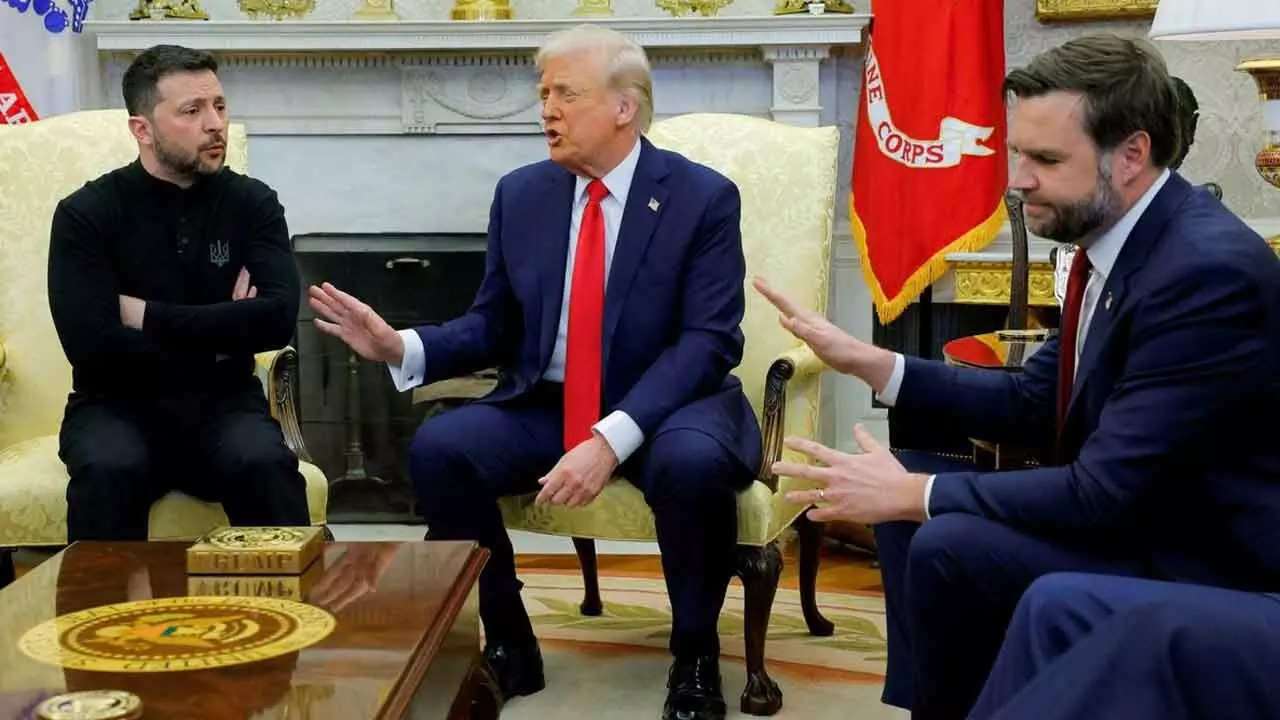Oval Office Diplomatic Meltdown Raise More Questions Than Solutions
The Oval Office fiasco proves that diplomacy works best behind closed doors—Reality TV-style theatrics only leave red faces and fractured alliances
Oval Office Diplomatic Meltdown Raise More Questions Than Solutions

The Oval Office meeting was pushed by Zelensky to finalise a mineral deal that was supposed to be mutually beneficial. Rubio called it a fair agreement, emphasising that Ukraine stood to gain 50 per cent of the revenue
The diplomatic "Meltdown in the Oval Office"—or call it Reality TV-style diplomacy—will serve as a case study in "what not to do in international relations" for budding diplomats and students of global affairs for decades to come.
According to POLITICO, a U.S.-based media outlet generally centre-aligned, Ukraine’s President Volodymyr Zelensky walked into an 'ambush' orchestrated by the Trump administration.
The EU and America are split over who triggered the diplomatic crisis, calling it a 'transatlantic rift' that has left 'Europe now standing alone against Russia,' as Le Monde described it.
According to top European news outlets, EU leaders are firmly backing Zelensky—not just with the 'Hug of Hope' between UK Prime Minister Keir Starmer and Zelensky, but also with billions in aid for Kyiv. The verbal clash between Zelensky, President Trump, and his team has raised more questions than it has answered.
What’s in the Mineral Deal for the US?
Ukraine is rich in mineral resources, particularly in Donetsk, Luhansk, and Zaporizhzhia, which hold large deposits of critical minerals. However, Russia currently occupies 40 per cent of these territories. Meanwhile, Dnipropetrovsk and Kirovohrad, still under Ukrainian control, offer significant reserves but require major infrastructure investments.
Analysts highlight that Ukraine possesses 22 of the EU’s 34 critical minerals, including lithium (one-third of Europe’s deposits), titanium (7 per cent of global output pre-war), and graphite (20 per cent of world reserves).
The Trump administration is pushing to secure these critical minerals as "repayment" for past and future U.S. support against Russia. The focus is on lithium, titanium, uranium, and rare earth elements—vital for technology, defence, and energy sectors—which the U.S. currently sources from Chinese supply chains.
What’s the Genesis of the Deal?
Volodymyr Zelensky first proposed the mineral deal as part of his “Victory Plan” in September 2024, offering mineral rights in exchange for continued US support. South Carolina Republican Senator Lindsey Graham later expanded on this, but Trump turned it into a major geopolitical bargaining chip.
According to US Secretary of State Marco Rubio, the Oval Office meeting was pushed by Zelensky to finalize a mineral deal that was supposed to be mutually beneficial. Rubio called it a fair agreement, emphasizing that Ukraine stood to gain 50 per cent of the revenue.
What’s in the Reconstruction Investment Fund for Kyiv?
The latest draft (now suspended) proposed a joint fund where Ukraine would receive 50 per cent of future revenues from state-owned minerals, oil, and gas—after operating costs. Initially, U.S. recovery was capped at $500 billion, but Zelensky rejected this, arguing that it would bankrupt future generations of Ukrainians.
To counter this, the U.S. modified the deal into a “long-term financial commitment,” ensuring funds were reinvested into Ukraine’s reconstruction—specifically in mining, ports, and power grids.
Did the US Avoid Hard Security Guarantees?
Zelensky pushed for ironclad U.S. protection against Russia, but the U.S. offered only vague assurances of “support”—without any commitment to troops or additional weapons.
What Changed Zelensky’s Mind?
After the Oval Office debacle, Zelensky claimed in a TV interview with a U.S. media outlet that he believed the mineral deal was surrendering the rights of his people and country—So, what flipped between September 2024 and now?- since he’s the one who made the offer in the first place. He has rejected any territorial deal with Russia without Ukraine's involvement. So, did Zelensky read and fear this non-security commitment as a sell-out by Trump to Putin?
Rubio tagged Trump as a deal maker, so the bigger question is—has the Trump administration cut a backchannel deal with Putin for mineral extraction? Because without it, American companies won’t snag a penny’s worth of minerals from Russian-occupied territories.
The Fallout: EU Steps in
One thing is certain: the Oval Office clash has given EU leaders an opportunity to rally. “Many democratic European leaders have expressed their support for Zelensky,” who arrived in London for a summit on March 2.
The EU has already been at odds with Trump, particularly regarding NATO’s future, funding, and the U.S. role in European security.
“We stand with Ukraine for as long as it takes,” UK Prime Minister Keir Starmer told the press in London. Other European leaders have also voiced their support for Zelensky. Will the Oval Office meltdown directly hit the American credibility among its allies? Could the EU now take a hard stance against the U.S. in support of Zelensky?
The Rise of a European Army?
Zelensky has seized this opportunity to push for a unified European Army, stating unequivocally, “Europe needs its own army” to ensure self-sufficiency and security. He also called on Europe to “decide its own future.”
A Turning Point for Ukraine and the EU?
Will this diplomatic fiasco become a turning point for Ukraine and the EU? Only time will tell.
For now, the Oval Office showdown will continue to be dissected in global power corridors as world leaders brace for the possibility that Trump’s team could pull the same diplomatic manoeuvre on them.
(The author is Founder of My Startup TV)

